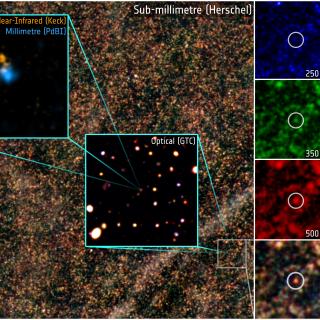Bibcode
Poidevin, F.; Omand, C. M. B.; Könyves-Tóth, Réka; Pérez-Fournon, I.; Clavero, R.; Geier, S.; Jimenez Angel, C.; Marques-Chaves, R.; Shirley, R.
Bibliographical reference
Monthly Notices of the Royal Astronomical Society
Advertised on:
6
2023
Citations
11
Refereed citations
9
Description
New optical photometric, spectroscopic, and imaging polarimetry data are combined with publicly available data to study some of the physical properties of the two hydrogen-poor superluminous supernovae (SLSNe) SN 2021bnw and SN 2021fpl. For each SLSN, the best-fitting parameters obtained from the magnetar model with Modular Open-Source Fitter for Transients do not depart from the range of parameter obtained on other SLSNe discussed in the literature. A spectral analysis with SYN++ shows that SN 2021bnw is a W type, fast evolver, while SN 2021fpl is a 15bn type, slow evolver. The analysis of the polarimetry data obtained on SN 2021fpl at four epochs (+1.8, +20.6, +34.1, and +43.0 d, rest frame) shows >3σ polarization detections in the range of 0.8-1 per cent. A comparison of the spectroscopy data suggests that SN 2021fpl underwent a spectral transition a bit earlier than SN 2015bn, during which, similarly, it could have underwent a polarization transition. The analysis of the polarimetry data obtained on SN 2021bnw does not show any departure from symmetry of the photosphere at an empirical diffusion time-scale of ≈2 (+81.1 d rest frame). This result is consistent with those on the sample of W-type SLSN observed at empirical diffusion time-scale ≤ 1 with that technique, even though it is not clear the effect of limited spectral windows varying from one object to the other. Measurements at higher empirical diffusion time-scale may be needed to see any departure from symmetry as it is discussed in the literature for SN 2017egm.
Related projects

Anisotropy of the Cosmic Microwave Background
The general goal of this project is to determine and characterize the spatial and spectral variations in the temperature and polarisation of the Cosmic Microwave Background in angular scales from several arcminutes to several degrees. The primordial matter density fluctuations which originated the structure in the matter distribution of the present
Rafael
Rebolo López

Formation and Evolution of Galaxies: Observations in Infrared and other Wavelengths
This IAC research group carries out several extragalactic projects in different spectral ranges, using space as well as ground-based telescopes, to study the cosmological evolution of galaxies and the origin of nuclear activity in active galaxies. The group is a member of the international consortium which built the SPIRE instrument for the
Ismael
Pérez Fournon